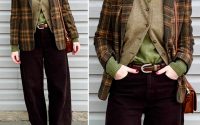At the commencing of the year, I wrote about my aim of searching extra mindfully and deliberately heading ahead. As I have been working on it, and performing by way of my thoughts on intake and shopper lifestyle extra normal as I produce my e book (additional on that later on), my perspective has been evolving — and my technique alongside with it. I needed to document that course of action below, as I imagine it’s a practical companion piece to my browsing- and design-oriented posts. Most of the time, on social media and elsewhere, we are presented with the effects of usage devoid of any context, divorced from its real-lifetime implications, personalized or societal. And I imagine context is critical when we are making an attempt to align our actions with our values.
My authentic emphasis had been to make much more intentional choices about my dresses buying, but that has been expanded noticeably. The a lot more I started out to pay out notice to what (apparel) I was acquiring and thinking about why I preferred or did not want to obtain them, the much more I understood it was a broader problem. I want to be a lot more intentional about all of my use, not just clothes. There are specific inquiries I now try to talk to myself each time I am contemplating a non-important, discretionary invest in. I say “try to” simply because this level of mindfulness represents a new pattern — one particular that really a lot goes versus our socio-cultural conditioning in a capitalist culture — and new habits choose time to root. It’s straightforward to just abide by aged styles of behaviour with out even knowing it. So part of the system involves attempting different suggests of disrupting the outdated patterns and reinforcing the new ones. I’ll speak about a few of these methods I’m hoping out below, but below are the questions I’ve found valuable in guiding my reflection on buys.
1) What value does this product bring to my lifetime?
2) How does this product align with my eyesight of what my very best existence appears to be like?
3) Am I willing to just take duty for this merchandise?
The third concern is one particular I have been pondering about a good deal these days. As I’ve been working on my e book, I’ve been reflecting not only on how I have interaction with shopper lifestyle in the context of my fascination in fashion, but also (much more broadly) on my connection with product factors. I have occur to believe that that capitalism has fundamentally and detrimentally impacted the way we relate to content points, i.e. the issues we acquire and take in. This is especially real with apparel. Clothes has grow to be so low cost and so improperly designed which potential customers people to view it as disposable. If a little something is disposable, we are not inclined to be aware about it — both in the way we buy it, or the way we take in it, or the way we dispose of it. To diverse extents, based on a range of components such as rate and societal messaging, I feel the same mentality applies to all client merchandise.
Overproduction of affordable products is an tremendous burden on our world inexpensive merchandise acquire a huge sum of means to produce, and also to dispose. To manufacture a pair of jeans, it choose choose up to 7,000 liters of h2o and produce about 20.04 kg of CO2 (the equal of driving about 42 miles in your vehicle) — not to mention the human labour involved. Then there are the assets expected to get those people denims from the manufacturing facility to the client. (Plenty of carbon emissions involved there.) And on the back again close? What’s the influence of a pair of jeans — a single of millions — in the landfill? Now multiply that throughout not just the manner marketplace but other sectors of retail. Assume, for example, of all that plastic seasonal décor that gluts suppliers quite a few moments a yr. How considerably of that is utilized just the moment, then tossed? How much of that is certainly recycled or reused? Certain, some of it can be held in circulation by using thrift outlets, but how a lot? Or how tiny, instead. When new merchandise are so cheap and obtainable, most folks aren’t determined to go to a thrift store for their, say, Easter decoration requires.
I think this mentality can be changed, but it involves us to glance at things otherwise — and not via capitalism’s most well-liked lens. What if I advised you: if you buy this pair of denims, you are now liable for it. Dependable to the the particular person who designed it, even though respiratory in a bunch of harmful chemical compounds functioning upwards of 12 hrs a working day and building fewer than a dwelling wage. Dependable to the earth and absolutely everyone else who life in this article. Responsible to acquire treatment of individuals denims even though they are in your possession, and also responsible for a disposal system (should really you no extended desire to possess them) that minimizes environmental impacts. Wouldn’t that give you pause?
It is a large load — at minimum, it feels that way to me. It actually does make me feel incredibly, incredibly hard about what I’m getting. For a get started, it actually will help me to aim and be incredibly straightforward with myself about the price proposition. How considerably value does this non-essential merchandise deliver to my lifetime and is that really worth the responsibility? Good quality turns into a lot much more vital. Why would I make investments so a great deal time and power (to fulfill my obligations as a responsible operator) in an product which is crappy top quality? It is so considerably tougher to assure that the merchandise has a upcoming right after me, if it is crappy — why would anyone else want a crappy secondhand merchandise? When it will come to clothes, in specific, this is a extremely essential thought. “If I really don’t like it, I’ll just donate it” is not a feasible disposal plan until there is a sensible prospect that another person else will want to invest in it. So, basically, thrift merchants simply cannot be our solution to Shein clothes.
I want to be clear right here that my perspective is very significantly geared towards discretionary intake inside of an affluent (or somewhat so) demographic. I believe our responsibilities as consumers are in proportion to our diploma of privilege and electricity.
One particular thing I have began to do, as part of my initiatives to entrench these queries and this framework of use into my each day life, is to keep track of what I simply call “no spend” times. Mainly, I preserve observe of times when I make no purchases that stand for discretionary intake. In this context, “consumption” is typically involved with substance objects, but can also include some styles of providers, like beauty treatment options. My target with this work out is not to track spending from the economical aspect it is to prompt me to acquire discover of when I am creating selections that include consumption, so that I can make positive to question myself the essential concerns. I am not including what I would deem “essential” use — food items, utilities, residence servicing costs, insurance, and so forth. — due to the fact, effectively, present in the world would make some stage of usage unavoidable, and I come to feel like the most effective concentration for my notice is on the “extra” things.
I have no specific targets for my no-devote times, although I do like possessing uninterrupted streaks — my longest so considerably becoming 5 times. I really don’t want to “gamify” this process too a lot due to the fact I experience that would final result in redirecting the focus away from what I am worried with. It is not about how a great deal I spend or when I invest or even if I shell out. It’s about making absolutely sure that if and when I commit, it is mindful and intentional. Allow me set it this way: if I only experienced one particular “spend” day a month, and it included a dozen mindless buys, that wouldn’t be a acquire in my reserve.
Yet another physical exercise I started out undertaking was holding a running list of merchandise I was tempted to purchase but did not. I’ve been undertaking this a lot, in individual, with Poshmark listings. I nevertheless consistently check out the application, as I am wanting for quite precise factors and want to make absolutely sure I’m in the suitable location at the proper time if the excellent listing pops up. But in executing so, I inevitably appear throughout other objects that attraction to me. I incorporate them to my “liked” listing so I can preserve observe of them, but I test to wait at the very least a several days ahead of I make any obtaining conclusions, to give myself ample time to replicate on my issues. Often, items market during that time or I finally determine than I do not genuinely need to have/want them. At that level, I set them on my “didn’t buy” listing. It’s a thing I can glance back on afterwards, each time I need to have a reminder that some desires are, in actuality, momentary. It also can help me to hold track of prices on items that I’m however intrigued in (but have not yet committed to shopping for). I have been performing this with vintage Coach bags, in certain I am hunting for sure unique kinds, but I will keep keep track of of comparable bags I discover and really do not invest in on-line, and jot down the selling prices at which they marketed. It’s a fantastic way of remaining on best of the market, which will help me to evaluate the price ranges of upcoming listings.
I have only been actively carrying out these training for a minimal about a thirty day period now, but I can confidently say that they are aiding me to transform my behavior, very little by minimal. I know there is a great deal to unpack listed here, and a large amount more that I am nevertheless doing work my way as a result of in my have brain, but I hope you will come across some of it valuable or intriguing in the context of your individual encounters.
And, sure, I am writing a e-book. It will be a memoir about my lookup for id and the position of fashion/individual design in that procedure. But also about so much additional — contemplate this publish a tiny style of that. I am now wrapping up my first spherical of edits, and hope to have a totally revised draft in the future few of months. Outside of that, I do not know what, if anything at all, will materialize. It feels too mind-boggling — and counter-successful to my innovative approach — to feel about how (or if) I want to put my creating out into the entire world. I’ll continue to keep you posted on that 😉
Like this:
Loading…





![13 Best Sites to Stream UFC Live Online for Free [2024] 13 Best Sites to Stream UFC Live Online for Free [2024]](https://appearworld.com/wp-content/uploads/2024/11/13-Best-Sites-to-Stream-UFC-Live-Online-for-Free-200x125.jpg)


